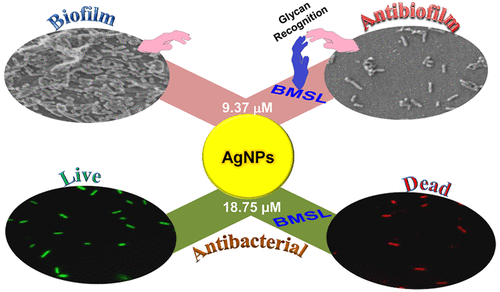当前位置:
X-MOL 学术
›
Bioconjugate Chem.
›
论文详情
Our official English website, www.x-mol.net, welcomes your
feedback! (Note: you will need to create a separate account there.)
Revealing the Significance of the Glycan Binding Property of Butea monosperma Seed Lectin for Enhancing the Antibiofilm Activity of Silver Nanoparticles against Uropathogenic Escherichia coli.
Bioconjugate Chemistry ( IF 4.0 ) Pub Date : 2020-01-03 , DOI: 10.1021/acs.bioconjchem.9b00821 Siva Bala Subramaniyan 1 , Rajendran Senthilnathan 1 , Jothi Arunachalam 1 , Veerappan Anbazhagan 1
Bioconjugate Chemistry ( IF 4.0 ) Pub Date : 2020-01-03 , DOI: 10.1021/acs.bioconjchem.9b00821 Siva Bala Subramaniyan 1 , Rajendran Senthilnathan 1 , Jothi Arunachalam 1 , Veerappan Anbazhagan 1
Affiliation

|
The incompetence of conventional antibiotics against bacteria residing in biofilms demands newer therapeutic intervention. In this study, we demonstrated that the interaction between silver nanoparticles (AgNPs) and Butea monosperma seed lectin (BMSL) forms efficient surface-functionalized AgNPs with excellent antibiofilm competency against uropathogenic Escherichia coli (UPEC). The minimum biofilm inhibitory concentration (MBIC) of AgNPs and the BMSL-AgNP conjugate (BAgNP) against UPEC was 75 and 9.37 μM, respectively. The eight-fold reduction in the MBIC of AgNPs was attributed to lectin functionalization. The chemical modification of serine amino acids affects the hemagglutination activity of BMSL but not its interaction with the AgNPs. At the same time, AgNPs surface-functionalized with modified BMSL display poor antibiofilm activity. Molecular docking studies revealed that BMSL binds to galactose with a free energy of -5.72 kcal/mol, whereas the serine residue-modified BMSL showed the lowest free energy values, suggesting incompetence for binding galactose. These results showcase that the sugar binding site of BMSL aids in the adhesion of AgNPs to the biofilm matrix and disturbs the formation of the biofilm, which was confirmed by light microscopy using crystal violet staining. At 37.5 μM, BAgNPs also have the capability to eradicate preformed biofilm. As a proof of concept, UPEC biofilm prevention and eradication were demonstrated on a urinary catheter. A scanning electron microscopy study showed that BAgNPs prevent bacterial colonization and thereby curtail biofilm growth. In addition to antibiofilm activity, BAgNPs exert antibacterial activity at 18.75 μM, which is four-fold lower than the MIC of AgNPs. A mechanistic study revealed that BAgNPs affect the integrity of the bacterial outer membrane and generate an imbalance in the antioxidant defense, which induces cell death. The results highlight that lectin functionalization can be extended to other nanoparticles and different antibiotics to enhance their efficacy against drug-resistant bacteria.
中文翻译:

揭示了单精子种子凝集素的多糖结合特性对增强银纳米颗粒对致病性大肠杆菌的抗生物膜活性的意义。
常规抗生素对生物膜中细菌的抵抗力不足,需要进行新的治疗干预。在这项研究中,我们证明了银纳米粒子(AgNPs)和单精子种子凝集素(BMSL)之间的相互作用形成了有效的表面官能化AgNPs,具有抗尿路致病性大肠杆菌(UPEC)的出色的生物膜能力。AgNP和UPEC的BMSL-AgNP共轭物(BAgNP)的最小生物膜抑制浓度(MBIC)分别为75和9.37μM。AgNPs的MBIC降低八倍归因于凝集素功能化。丝氨酸氨基酸的化学修饰影响BMSL的血凝活性,但不影响其与AgNP的相互作用。同时,用修饰的BMSL表面功能化的AgNPs表现出较差的抗生物膜活性。分子对接研究表明BMSL以-5.72 kcal / mol的自由能结合半乳糖,而丝氨酸残基修饰的BMSL显示出最低的自由能值,表明结合半乳糖的能力不强。这些结果表明,BMSL的糖结合位点有助于AgNPs与生物膜基质的粘附并干扰生物膜的形成,这已通过使用结晶紫染色的光学显微镜得到了证实。BAgNPs的浓度为37.5μM,也具有根除预先形成的生物膜的能力。作为概念的证明,在导尿管上证明了UPEC生物膜的预防和根除。扫描电子显微镜研究表明,BAgNPs可以防止细菌定植,从而减少生物膜的生长。除了具有抗生物膜活性外,BAgNP还具有18.75μM的抗菌活性,这比AgNP的MIC低四倍。一项机械研究表明,BAgNPs影响细菌外膜的完整性,并在抗氧化剂防御中产生不平衡,从而导致细胞死亡。结果表明,凝集素功能化可以扩展到其他纳米颗粒和不同的抗生素,以增强其抗药性细菌的功效。
更新日期:2020-01-04
中文翻译:

揭示了单精子种子凝集素的多糖结合特性对增强银纳米颗粒对致病性大肠杆菌的抗生物膜活性的意义。
常规抗生素对生物膜中细菌的抵抗力不足,需要进行新的治疗干预。在这项研究中,我们证明了银纳米粒子(AgNPs)和单精子种子凝集素(BMSL)之间的相互作用形成了有效的表面官能化AgNPs,具有抗尿路致病性大肠杆菌(UPEC)的出色的生物膜能力。AgNP和UPEC的BMSL-AgNP共轭物(BAgNP)的最小生物膜抑制浓度(MBIC)分别为75和9.37μM。AgNPs的MBIC降低八倍归因于凝集素功能化。丝氨酸氨基酸的化学修饰影响BMSL的血凝活性,但不影响其与AgNP的相互作用。同时,用修饰的BMSL表面功能化的AgNPs表现出较差的抗生物膜活性。分子对接研究表明BMSL以-5.72 kcal / mol的自由能结合半乳糖,而丝氨酸残基修饰的BMSL显示出最低的自由能值,表明结合半乳糖的能力不强。这些结果表明,BMSL的糖结合位点有助于AgNPs与生物膜基质的粘附并干扰生物膜的形成,这已通过使用结晶紫染色的光学显微镜得到了证实。BAgNPs的浓度为37.5μM,也具有根除预先形成的生物膜的能力。作为概念的证明,在导尿管上证明了UPEC生物膜的预防和根除。扫描电子显微镜研究表明,BAgNPs可以防止细菌定植,从而减少生物膜的生长。除了具有抗生物膜活性外,BAgNP还具有18.75μM的抗菌活性,这比AgNP的MIC低四倍。一项机械研究表明,BAgNPs影响细菌外膜的完整性,并在抗氧化剂防御中产生不平衡,从而导致细胞死亡。结果表明,凝集素功能化可以扩展到其他纳米颗粒和不同的抗生素,以增强其抗药性细菌的功效。











































 京公网安备 11010802027423号
京公网安备 11010802027423号